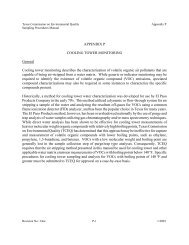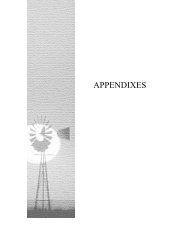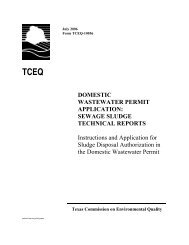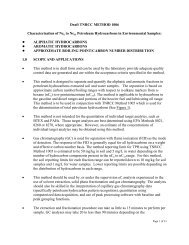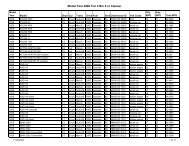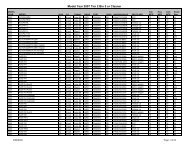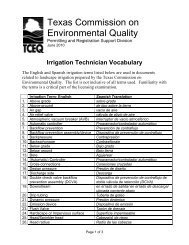Create successful ePaper yourself
Turn your PDF publications into a flip-book with our unique Google optimized e-Paper software.
• Channel catfish Ictalurus punctatus – sport fish; nest builder; omnivore; juveniles<br />
use riffle habitat, whereas adults prefer run or pool habitat.<br />
• Flathead catfish Pylodictis olivaris – large long-lived catfish; utilize deeper areas<br />
of rivers with slow to moderate velocity and heavy cover such as rocks or<br />
submerged wood; builds nests in natural cavities; young utilize riffle habitat;<br />
piscivorous.<br />
• Bluegill Lepomis macrochirus – utilize pool habitat, feeding mainly on<br />
invertebrates; nest builder that spawns in spring and summer.<br />
• Largemouth bass Micropterus salmoides – sport fish; found in low velocity<br />
mesohabitats such as pools and backwaters; piscivorous; nest builder.<br />
• Guadalupe bass Micropterus treculii - endemic to the Edwards Plateau region of<br />
central Texas; habitat utilization changes with life stage; juveniles occupy shallow<br />
runs over various substrate types; adults utilize swift deep runs and pools<br />
downstream of riffles where they prey on insects, crayfish, and small fish;<br />
spawning occurs in the spring; nests constructed by the male in shallow water;<br />
present throughout the <strong>Colorado</strong> <strong>River</strong> Basin but most abundant in clear water<br />
reaches throughout the middle sub-basin watersheds including the Pedernales,<br />
Llano, and San Saba drainages; species of concern (Texas Wildlife Action Plan).<br />
• Texas logperch Percina carbonaria – endemic to the Edwards Plateau region of<br />
central Texas; inhabit rocky riffles and runs with relatively fast current; feed on a<br />
variety of aquatic insect larvae; spawn from January to June in the <strong>Colorado</strong><br />
<strong>River</strong>; eggs and larvae can tolerate temperatures between 22 to 26°C; pollution<br />
intolerant species.<br />
• Dusky darter Percina sciera – prefers riffle/run habitat, often associated with<br />
other cover such as boulders or logs; spawn over gravelly substrates from<br />
February through June in the <strong>Colorado</strong> <strong>River</strong>; brood hider; invertivore.<br />
• Macrobrachium spp. – migratory species; special concern species (Texas<br />
Wildlife Action Plan).<br />
Lavaca <strong>River</strong> <strong>Focal</strong> <strong>Species</strong><br />
• American eel Anguila rostrata – catadromous; piscivore; different life stages may<br />
use varying habitats; selected for longitudinal connectivity given free run of<br />
Lavaca <strong>River</strong>; special concern (Texas Wildlife Action Plan).<br />
• Ribbon shiner Lythrurus fumeus – broadcast spawner; invertivore;<br />
representative of pools or backwaters with weak current;<br />
• Channel catfish Ictalurus punctatus – sport fish; nest builder; omnivore; juveniles<br />
use riffle habitat, whereas adults prefer run or pool habitat.




